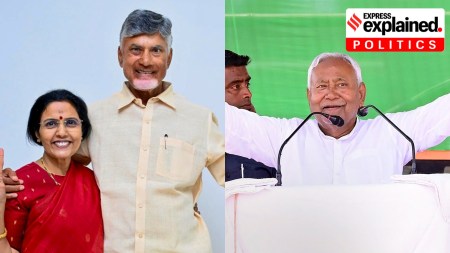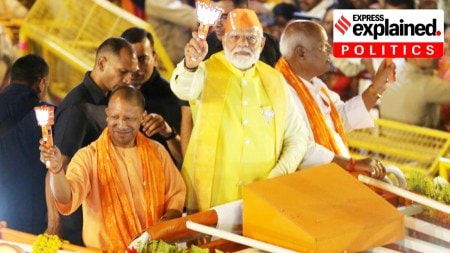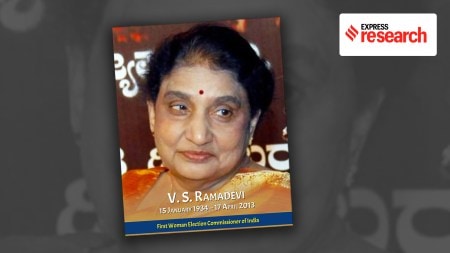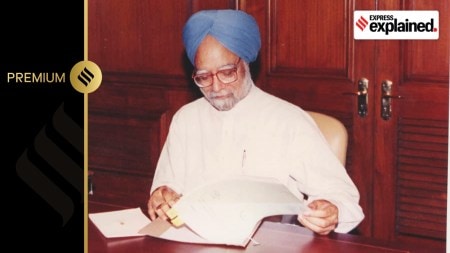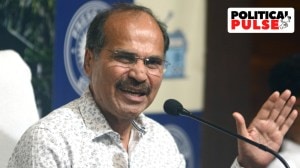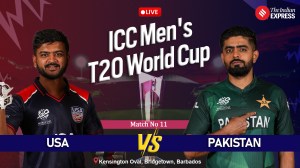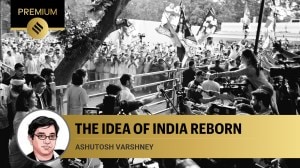- India
- International
Gary Kirsten: ‘The most successful franchises in IPL history have had the least amount of player churn’
With barely any previous coaching experience, Gary Kirsten guided India to the 2011 World Cup title. He moved on to coach his country South Africa and a few T20 franchises, including Royal Challengers Bangalore. One of cricket’s most astute brains is back at the Indian Premier League to tackle a different challenge as mentor and batting coach of new franchise Gujarat Titans.
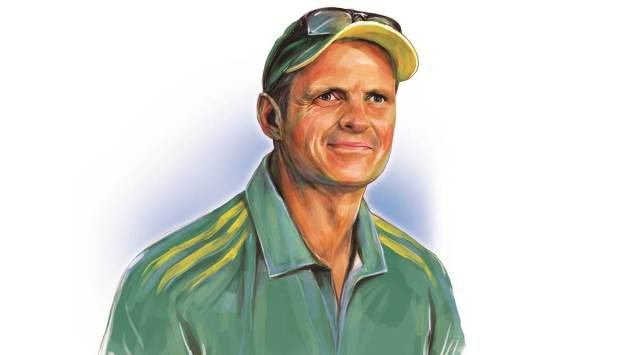 Team's mentor Gary Kirsten. (FILE)
Team's mentor Gary Kirsten. (FILE)Gary Kirsten talks about guiding young Indian talent in the IPL, his coaching philosophy, memories of the 2011 World Cup win and providing opportunities to township players back home in South Africa. The session was moderated by Sandeep Dwivedi, National Sports Editor, The Indian Express
Sandeep Dwivedi: Long before you became the World Cup-winning India coach, you were a household name in India as a cricketer. A solid opener, you seemed to have cracked that run-making code. How did you evolve as a batsman?
As a cricketer, you need to work something out. You need to come up with a plan to score runs. From a very young age, I was mentored by people who helped me understand how to perform. And, I think, by doing that, allowed me to kind of formulate my way of scoring runs. Like you rightly said, I wasn’t necessarily easy on the eye, but it was effective.
I do think there’s a real indication that young Indian players are feeling more comfortable in the IPL environment… It has created a platform for young Indian players to showcase their talent and they are embracing it
Sandeep Dwivedi: After Greg Chappell, India took a leap of faith and appointed you, someone with no real coaching experience. It is said, India needed a coach of a certain personality type — they wanted someone the dressing room could trust and not someone who would thrust his way (on the players).
It was a journey with the Indian players in terms of a team going from an average performing unit to the best in the world. There is always talent in the team, skill and ability, but I think it was about helping the team understand how everyone needed to fly in formation. That is what teams are about, a bunch of individuals coming together. There are certain things that you do in a team environment that allow consistency for performance.

Sandeep Dwivedi: There is this one picture from the World Cup final win at the Wankhede Stadium, where the players are trying to lift you on their shoulders and you are almost embarrassed. You are not the kind of person who would want to be in the spotlight…
Yeah, absolutely. I think that’s what coaching is about. I don’t necessarily feel that I need to be lifting trophies; the players are the ones who need to do that. I just enjoy the work. For me, the highlight with India was the three-year journey of starting out as a young inexperienced coach to walking a journey with the players. We could excel over a three-year period and watch individuals give the most prolific performance of their careers. Certainly, a lot of the batsmen were playing the best cricket of their lives at that point. So that was the fun part.
Sandeep Dwivedi: Even (MS) Dhoni is rarely seen in the frame when the team is celebrating or posing with the Cups. How exactly did you read this?
I think he’s just an ultimate team player. He is a great leader, his interest is in the performance of the team. As a captain, his mindset was always to look at the team first and see at the way the team could be thriving. He never dwelled on his own performances. His focus was always on how the team could do well.
The only way to coach is to allow every player the opportunity to explore his talent. In a high-risk game of short-format cricket, chances of consistent success aren’t necessarily always going to be there
Sandeep Dwivedi: How difficult or easy was it for you to walk away after the team had won the World Cup?
No, it wasn’t difficult; I think it was very clear to me that the journey of three years would end with the World Cup. My personality is such that it is easy for me to move on. I look at those three years as a much cherished time of my life and a massive privilege. In international coaching, you are a custodian of the environment just for a short period of time, it’s not going to last forever. So, just enjoy it and get the most out of it. I couldn’t have thought of a better time to move on from the job.
Sandeep Dwivedi: You always talk about how the process and journey is more important than the destination. How difficult it is as a coach of a franchise team because of the investment that is being made by the owners and the related pressures? The bottom line is always about winning. So, what happens about the grand plan about building a team? If the results don’t go your way, at times, does it become difficult? Do you change your plan?
There is massive pressure on short-term results. Often, the evolution of a team takes time. The danger in any franchise is to make crisis-management decisions where you are chopping and changing the team a lot because you think someone else is going to do a better job than the guy that you originally put in the team. I think one needs to be careful of that. The most successful franchises in IPL history have been the ones that have had the least amount of player churn because they have stuck with players and backed them. From a coaching perspective, the only way to coach is to allow every player the opportunity to explore his talent. In a high-risk game of short-format cricket, chances of consistent success aren’t necessarily always going to be there. There is going to be a lot of hit and miss along the way. But if players show potential, then you’ve got to back them all the way, even though they might not be performing.
As a captain, Dhoni’s mindset was always to look at the team first and see the way it could be thriving. He never dwelled on his own performances. His focus was always on how the team could do well
Sandeep Dwivedi: Your assistant during your time with the Indian team, Paddy Upton, in his book, mentions a meeting with Team India. That was probably your first meeting with the team. You made a grand presentation about a strategy and you were quite happy with how it went. After the meeting, Paddy tells you, ‘Don’t think it landed’. How difficult it is to connect with a team where players have different backgrounds? More so in the IPL, where a team has players from different countries…
I think the biggest priority, especially as a foreign coach, is to really take time to understand the people and build a connection and relationship. It is much harder when you have got language and cultural barriers as well. So, you need to take a little bit more time and effort into building up those relationships. The other side is to understand people off the field, not just on the field. They are treated as performance tools, and there’s an expectation on them to perform. But the better you understand them as people, the more influence you can have over them as leaders. We all would have examples of people trying to lead us where we don’t trust them. They are not going to get much out of us. So, I think that was a priority for me. There was good learning from that first interaction where I thought I would need to present a way to the team rather than just be authentic in front of the team and grow with them.
Sriram Veera: I heard a podcast where you talk about predetermination and batting. You are saying a little predetermination is good.
I think there is a lot more thought that goes into a bowler’s plan, especially in the shorter format. I think, in Test-match cricket, because you have got a lot of time and you don’t have to make the play, you can just react a lot more. But, in 20-overs cricket, you need to take a chance on trying to work out what the bowling plan is. By doing that, you take a chance that the bowler is going to do something different and you set up yourself for a predetermined event.
Sriram Veera: Was it predetermination when you would walk down the track to bowlers? You were one of the early batsmen in ODI who would walk down the pitch. How did that come about?
It was something that I developed in my game. You needed to find a way to get the ball to the boundary in one-day cricket. So, it was like a release shot that I felt was fairly low risk. But that certainly did help me get the ball to the boundary when I was under pressure. So yes, it was something that I developed in my game that was really helpful to me.
Nihal Koshie: Hardik Pandya (who is captaining Gujarat Titans) in this IPL seems to be the same player he was before his injury. What were the conversations you had with him? He seems to be enjoying himself and the runs are back.
We’ve had a number of conversations, but, you know, the coaching conversations are mostly not about me giving him directions. It is more about me helping him understand what he wants to achieve with his batting. He has got some good clarity in that space. He realised that he’s going to play a very different role in this team as a batsman, compared to what he has done in his previous franchise. He has absolutely thrived in that new role. I mean, he’s class. He’s a fantastic batsman, he can play in a lot of different ways. He’s not one dimensional in his ball striking. He can rotate strike and he can get the ball to the boundary. Those kinds of batsmen are very dangerous. They can do different things on a field. I think he’s played with great maturity and he has handled the pressure situations really well when he walked into bat with two down quickly. So, I have been nothing but impressed with that journey.
Sandip G: Every coach has a guiding philosophy, What is yours?
I think every environment requires something different. So it’s really about understanding the environment you are working in. For example, working with a lot of senior players requires a different leadership as compared to when you are with a group of junior, inexperienced players. So, it’s really understanding that environment. Your style of leadership will be based on what the requirements are. Young players need a bit more guidance and direction. Senior players just need an environment where they feel they can make a contribution. I think a lot of it just depends on the environment that you are working in as a coach.
Sandip G: Does the dynamics of coaching change between formats such as white ball and red ball?
Yeah, there is a massive distinction. Because you are working with an international team, you have got a long time to work with individuals, and you are building relationships and a connection over a long period of time. Also, there are other stakeholders in your international team, there’s a lot of people in the country who are interested in the performance of the team. Franchise cricket is very different, because you have much less time. You are just trying to find your flow as a group and trying to get your balance with the team right.
It is largely focused — less on building relationships with your players, although, you try to do that in the short term — and more on understanding how you are going to win cricket games. That is really what franchise cricket is about. I think there’s space for game development at the franchise level, because there’s a lot of downtime between matches. But essentially, if you have got six to seven weeks to work on game development with someone, it’s not really enough time. I think you can create awareness around it. That’s about it.
Tushar Bhaduri: When the IPL started, teams were allowed to include four overseas players in the playing XI. Along with a couple of Indian star players, the foreign players were supposed to be the fulcrum of each side. Do you think it has evolved to an extent that now the domestic players are coming into their own and are taking responsibility? So many teams in this edition don’t even play the full complement of four foreign players. Do you think the disparity between foreign and Indian players is narrowing?
That is a good question and you are spot on. I do think there’s a real indication that young Indian players are feeling more comfortable in the IPL environment. I think so far this is a tournament of young Indian players. We have seen a number of them across the different teams really showcase their skills and are comfortable doing so in the pressurised environment of IPL. The IPL has created a platform for young Indian players to showcase their talent and they are embracing it. They are really taking the opportunity, which is very exciting. I think it’s a brilliant thing for Indian cricket to see these youngsters come through and play a brand of cricket that is very exciting.
Tushar Bhaduri: As a supplementary question to that, the Big Bash in Australia has two foreign players per playing XI. Do you think the IPL can now afford to have less than four foreign players in a XI? Or, is four the optimal number?
I think the foreign players definitely add value to the tournament. You just take the performances of Jos Buttler in this tournament. It has provided massive entertainment to the crowds and performances like that increase the standard and the quality of the event. You wouldn’t want that not to be the case. Our game against Rajasthan Royals had our young fast bowler Yash Dayal come in and bowl to Jos Buttler. If there is ever a richer and more pressurised experience that you are going to have, it’s that. So, that’s going to help him (Dayal) grow very quickly as a player and improve. I think the important thing is to make sure that your standard of competition is at its highest. And, I think all international players would tell you that the quality of the IPL is as good as anywhere in the world, if not better than anywhere in the world at franchise level.
Devendra Pandey: You have worked with players like (Sachin) Tendulkar, (Rahul) Dravid, (VVS) Laxman in the past and now you have in your team Hardik and Shubman Gill. Do you see a change in mindset or approach towards the game?
I think you are comparing apples with pears in many ways. There was massive focus on one format 15 years ago. Now, the conversations I’m having with Indian players are all around short-format cricket. I am not involved in the longer version. If you are asking me if the conversation I had about Test cricket with the Indian players in 2008 as compared to young players now, I wouldn’t be able to answer you.
Shamik Chakrabarty: The young South African batsman Dewald Brevis had a rocking start to the IPL. Do you think he is the best young South African batting talent at the moment and should be fast tracked to the senior team?
He is an exciting talent and he seems to be embracing the IPL really well. That is great from a South African perspective. But it’s early days in his career. He is definitely showing massive potential. I don’t like to use the word ‘fast track’ because there is no such thing in batting. It takes time. You are going to have a lot of obstacles along the way. He has certainly shown signs and shown real promise in terms of an international career. But it’s still early days.
Sandeep Dwivedi: You have worked a lot to develop cricket in townships back in South Africa. How enriching is that experience to see them grow? As an international top coach, how fulfilling is that?
It is incredibly fulfilling because you are able to work with young and talented players who don’t necessarily have access to opportunity like a lot of other players do. To provide them with that opportunity is particularly fulfilling. In countries like India, South Africa, and all Test-playing nations, how many kids are out there who are really talented but never get the opportunity to showcase their talent because they don’t have a cricket bat that they can afford or they don’t have access to a cricket field where they could potentially play on? They don’t, in their jurisdiction, have an academy where they could go down and show people how talented they are. They just don’t have access to the game at all.
In South Africa that’s a big problem in our poorer communities — access to cricket is not always there. I guess it is different in India. You look around and there is informal sport taking place everywhere. In India, it seems like it is mainly just cricket matches going on. Whereas in South Africa, it’s probably football in the informal sector. So our foundation (Gary Kirsten Foundation) has tried to take cricket into one of those areas and create a high-performance facility, where young, talented players can walk a couple of 100 metre from their home and come and hit balls in a nice indoor centre or a field.
Jun 06: Latest News
- 01
- 02
- 03
- 04
- 05






